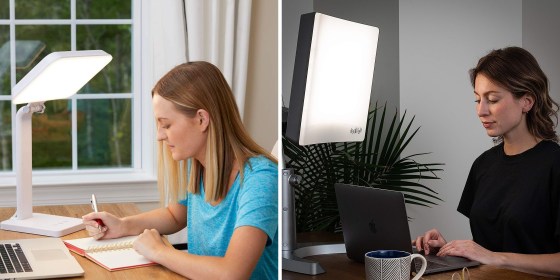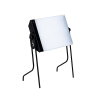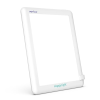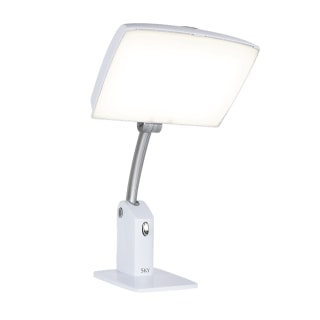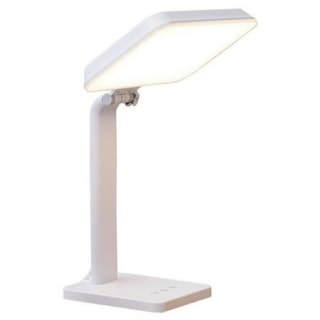As the sun rises later and sets earlier during the winter months, odds are you feel sleepier and less motivated compared to other times of year. To some degree, that’s totally normal, says Dr. Alex Dimitriu, founder of Menlo Park Psychiatry and Sleep Medicine. Our circadian rhythm and other biological clocks are regulated by sunlight, so when there’s less of it, we feel drained. Until the sun returns in the spring, you can replace missing daylight with light therapy lamps. These devices simulate the light of a sunny sky and can help boost your mood, among other benefits, according to experts.
Light therapy is one treatment option for those diagnosed with Seasonal Affective Disorder (SAD), a type of depression that follows a seasonal pattern and is impacted by daylight hours, says Dimitriu. But anyone experiencing the winter blues may benefit from light therapy. To learn more about these lamps — also commonly referred to as white light boxes, SAD lights, or ironically, happy lamps — we consulted experts.
How to shop for light therapy lamps
The U.S. Food and Drug Administration does not regulate light therapy lamps, and some options are poorly made, limiting their effectiveness, experts warned us. To ensure you’re purchasing a quality SAD lamp, look for those with the following features:
- Light intensity: Make sure you purchase a light therapy lamp that emits a 10,000 lux illuminance, says Dr. Michael Terman, founder and president of The Center for Environmental Therapeutics, a nonprofit research and education institution that’s considered an authority on light therapy. Lux is a measurement of light intensity, and 10,000 lux of light is comparable to ambient daylight. For comparison, typical room lighting ranges from 300 to 500 lux, according to Phillips.
- Light screen/panel size: Bigger is better when it comes to the size of a lamp’s light panel/screen, says Terman. That’s because you want to create a wide field of light around your face in order to get the full 10,000 lux “dose.” The Center for Environmental Therapeutics recommends a surface area that exceeds 200 sq. in., but this is made complicated by the fact that most at-home light therapy lamps are smaller in size compared to ones you might find in a doctor’s office. With that being said, try to purchase the largest size lamp you can given your space and budget limitations.
- UV protection: Overexposure to UV light can damage skin and is what we seek to protect skin from when we apply sunscreen. Because of this, it’s important to make sure you buy light therapy lamps designed with built-in UV-filters or that are labeled “UV-free.”
- Adjustability: Your light therapy lamp should not shoot light upwards into your eyes, and you should never look directly into the light, just like you should never look directly into the sun, says Terman. It’s best to have light come from above and shine down on you, similar to how sunlight does outdoors. Thus, looking for lamps with adjustable heads and stands is important. If your lamp is not adjustable, try stacking books or other objects and placing it on top, angling it toward you as best you can.
The best light therapy lamps to shop
Northern Light Technologies Boxelite-OS
This light therapy lamp comes recommended by The Center for Environmental Therapeutics, and Northern Light Technologies consulted with Terman about its design, ensuring it offers features proven effective through his research. The light is built with two adjustable legs and an adjustable light panel.
Lux: 10,000 lux at a distance of up to 14 in. | Light panel size: 15x12 in.
Carex Day-Light Sky Bright Light Therapy Lamp
Carex’s SAD lamp is designed with a stand that’s height- and angle-adjustable, allowing you to position it so light projects downward, as experts recommend. The lamp blocks UV light, according to Carex, and you can choose between two light settings: One for light therapy and one for general room lighting.
Lux: 10,000 lux at a distance of 12 to 14 in. | Light panel size: 13.5x10 in.
Theralite Aura Bright Light Therapy Lamp
Theralite’s light therapy lamp projects light downward and you can adjust the angle of the panel. The lamp has four light settings, and it’s FSA/HSA eligible.
Lux: 10,000 lux at a distance of 12 in. | Light panel size: 11.5x8 in.
Verilux HappyLight Lucent
Verilux sent me this light therapy lamp to try, and I now use it daily during the winter months. I elevate it on a stack of books and use it while I’m eating breakfast. When I’m done with my 30-minute session, I take the light panel off its detachable stand and place it in a drawer since it stores flat. You can use the lamp vertically and horizontally, and it’s UV-free.
Lux: 10,000 lux at a distance of 6 in. | Light panel size: 8.5x6.5 in.
Meet our experts
At NBC Select, we work with experts who have specialized knowledge and authority based on relevant training and/or experience. We also take steps to ensure that all expert advice and recommendations are made independently and with no undisclosed financial conflicts of interest.
- Dr. Alex Dimitriu is the founder of Menlo Park Psychiatry and Sleep Medicine and BrainfoodMD. He is double board-certified in psychiatry and sleep medicine.
- Dr. Michael Terman is the founder and president of the Center for Environmental Therapeutics, and a retired professor of Clinical Psychology in Psychiatry at Columbia University’s College of Physicians and Surgeons. At Columbia, he established a light therapy research lab, which developed a set of non-pharmaceutical measures to treat SAD as well as other light-responsive mental disorders. Dr. Terman also headed one of the original SAD research centers sponsored by the National Institutes of Health, where he introduced the standardized 10,000 lux light therapy method.
- Dr. Mariana Figueiro is the director of Mount Sinai’s Light and Health Research Center. She’s also a professor of population health science and policy.
Why trust NBC Select?
Zoe Malin is an associate updates editor at NBC Select who writes about health and wellness, including stories on KN95 masks, sunburn treatments and at-home COVID tests. For this article, she interviewed three experts about how to shop for light therapy lamps and rounded up expert picks and NBC Select staff recommendations.
Catch up on NBC Select’s in-depth coverage of tech and tools, wellness and more, and follow us on Facebook, Instagram, Twitter and TikTok to stay up to date.
